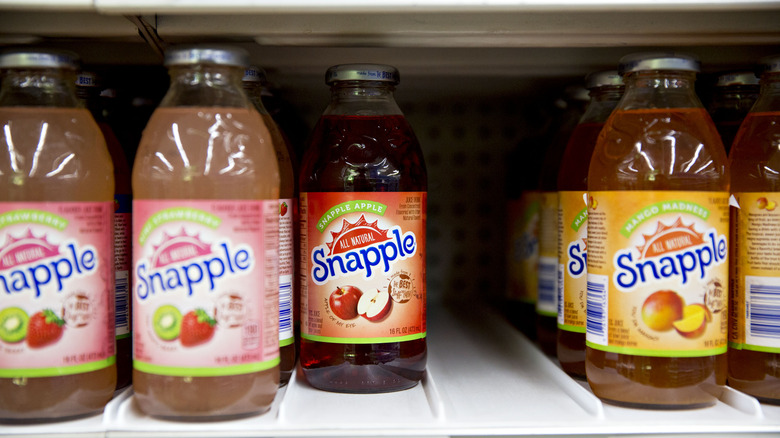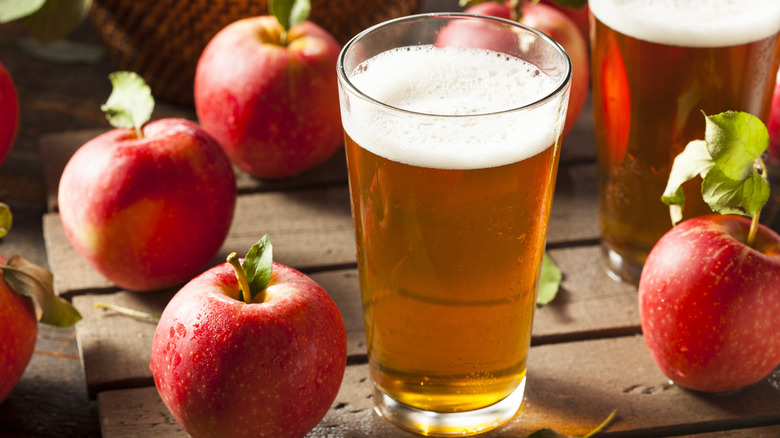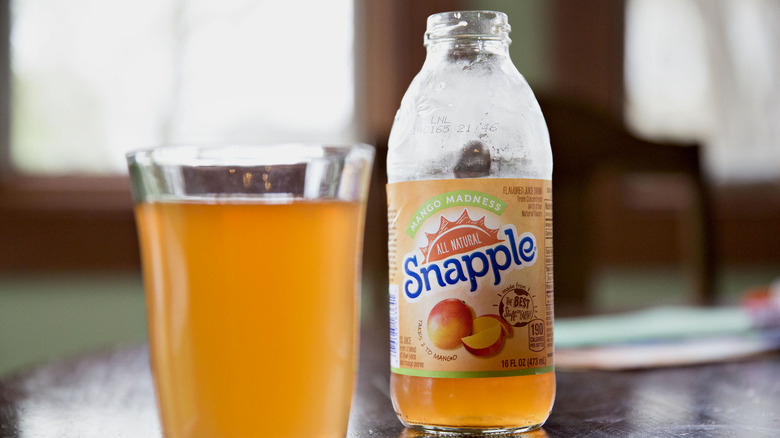How Snapple Got Its Name From Spoiled Apple Juice
Can you imagine if Snapple was actually a brand of hard cider? That may sound hysterical, but in its very early days, when the company was operating under the snazzy name of Unadulterated Food Products, there was some very real fermentation going on in the company warehouse. A batch of its fizzy apple juice was unintentionally fermenting, and — before anyone knew about the alcohol being created under their noses — the caps began to burst off of the bottles due to the gas inside. When the lids popped off, it made a snappy sound, a word the founders combined with the word "apple," for the juice in question, and "Snapple" was created.
The problem with the name? It was already spoken for by a Texas-based company. Undeterred, Unadulterated Food Products offered to buy the name for a mere $500, which the Lone Star state business agreed to. This all happened in the early 1980s when Snapple was enjoying moderate success, mostly around Brooklyn, New York where the company was founded. But when it introduced its Lemon Iced Tea in 1987, Snapple became a beverage force to be reckoned with, becoming the darling drink of Gen Xers, and coming out with several delicious flavors.
How the juice got spiked
So, what exactly happened with that fateful batch of sparkling apple juice that inspired the name of Snapple? To make a fizzy, non-alcoholic juice, carbon dioxide gas is added to the pressed fruit juice and is typically pasteurized to make it safe for consumption. The final product should, understandably, not contain any alcohol. Hard apple cider, on the other hand, does contain alcohol, which is a natural result of fermentation. Fermentation usually happens when yeast is added to fruit juice and begins to consume the sugars. The yeast then produces a gas and essentially converts the sugars from the juice into alcohol. Sometimes, a batch of apple juice can accidentally begin to ferment when it gets yeast in it and sits at room temperature. This is likely what happened in the case of proto-Snapple.
The gas that was being produced in the sealed bottles of sparkling apple juice built up pressure until it forced the lids off. It's possible the manufacturer simply didn't notice because the drink already had carbonation bubbles in it, hiding any alcohol that was masquerading as gas. Some of the batch actually made it to stores before the company realized the error. Needless to say, rave reviews of the sparkling apple juice were been pouring in at the time!
Goodbye sparkling apple juice, hello real facts
Although it makes more than 30 different flavors, Snapple no longer produces sparkling apple juice or any other carbonated varieties — but it does make the popular Snapple Apple and 100% Juiced Green Apple flavors. That isn't the only big change Snapple has seen in all its years. Much to the chagrin of lifelong fans, Snapple discontinued the use of their iconic glass bottles in 2018 and now packages its juices in 100% recycled plastic ones; however, each cap still contains a "real fact," which consists of a random piece of trivia created purely for entertainment purposes — it's something that the company is well known for.
You can even search all of Snapple's real facts on its website. Most of these tidbits of information have nothing at all to do with Snapple (like how mangos are related to pistachios or how you can theoretically start a fire with ice) — although fact number 1547 on the company's site states, "The Snapple name combines the words Snappy and Apple." You won't, however, find a fact that mentions the alcoholic bumble that led to the catchy word combination.



